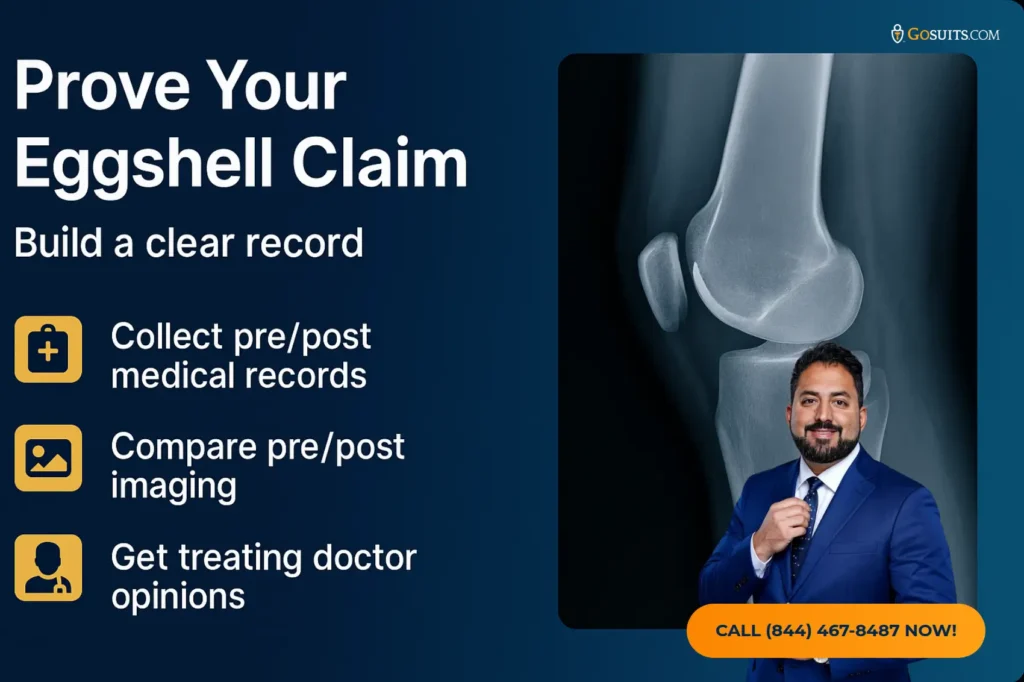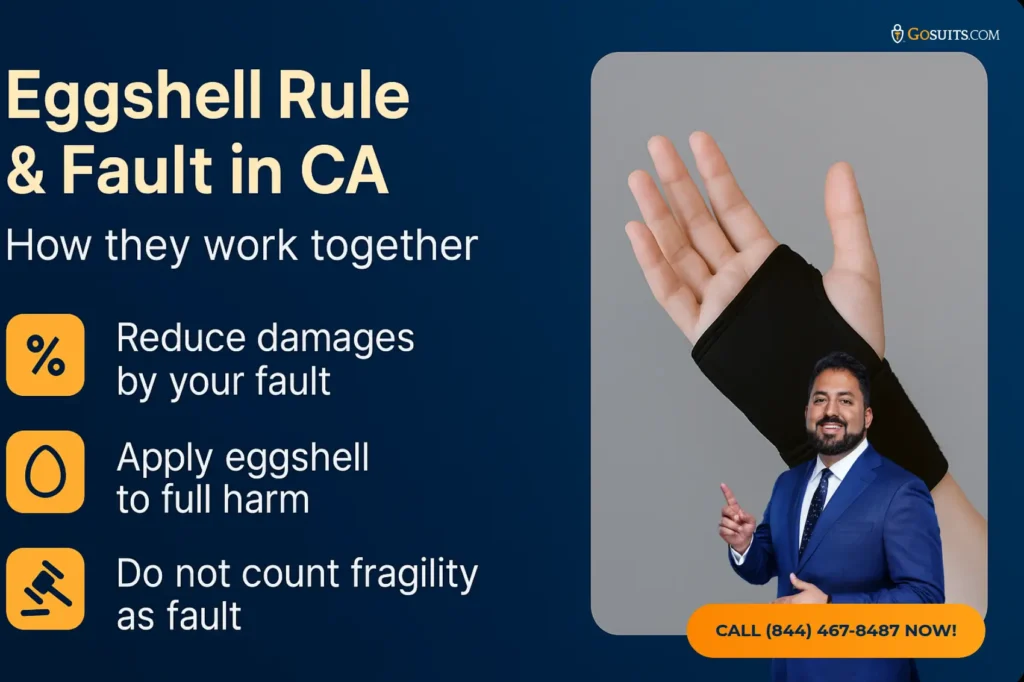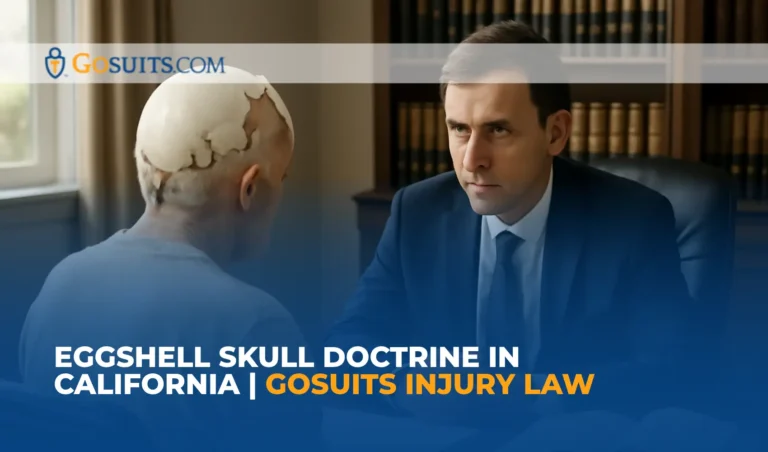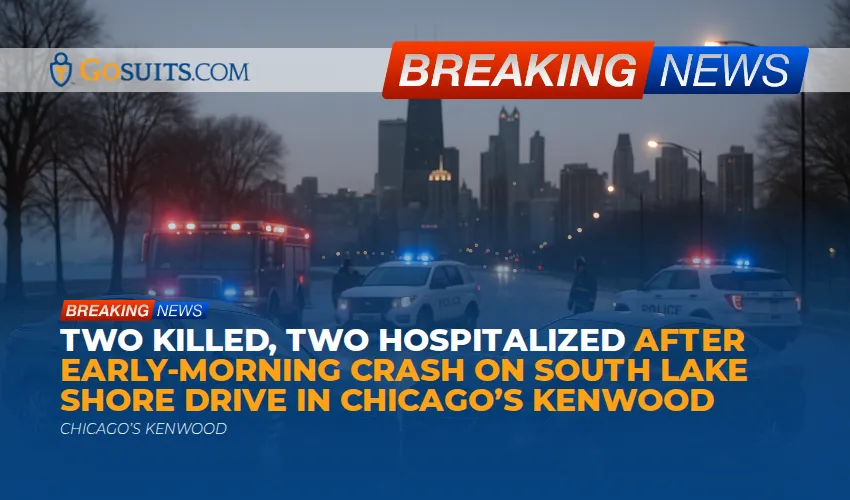- What is the eggshell skull doctrine in California?
- How does California’s “take your victim as you find them” rule work in civil cases?
- What do California jury instructions say about preexisting conditions and unusually susceptible plaintiffs?
- Does the eggshell plaintiff rule create liability for unforeseen injuries?
- How do causation and the burden of proof interact with the eggshell rule in California?
- What if a crash aggravated a preexisting condition in California?
- How do comparative fault and the eggshell doctrine work together in California?
- How are damages calculated when preexisting conditions are involved in California?
- What evidence helps prove an eggshell plaintiff claim in California?
- How do insurance companies respond and how can you protect your claim?
- How does the rule apply in car crashes, falls, products cases, and wrongful death in California?
- What deadlines and court rules matter for these claims in California?
- Does California’s thin skull rule apply to mental health vulnerabilities?
- What defenses do defendants raise and how are they evaluated?
- How does California compare to other jurisdictions on the eggshell rule?
- Quick FAQs about preexisting conditions and California personal injury law
- How can GoSuits help with an eggshell plaintiff claim in California?
- Sources and references
What is the eggshell skull doctrine in California?
You may have heard the phrase “eggshell skull” or “thin skull.” In California, this doctrine means a negligent person is liable for the full extent of the harm caused, even if the injured person was more fragile than an average person. Put simply, you take your victim as you find them. If a collision or fall triggers a serious outcome because of a preexisting condition, California civil law holds the at-fault party responsible for the worsened harm they caused.
This principle is widely recognized in U.S. tort law and is sometimes called the “eggshell plaintiff rule.” It is explained in plain terms by Cornell Law School’s Wex legal dictionary: a defendant is liable for a plaintiff’s injuries even when the plaintiff’s vulnerability makes the injury more severe than what would normally be expected from the defendant’s conduct. See Cornell Law: Eggshell Skull Rule.

How does California’s “take your victim as you find them” rule work in civil cases?
California courts apply the eggshell doctrine through standard jury instructions that guide jurors on damages when a person had a preexisting injury or was especially susceptible to harm. The rule does not expand liability to harms a defendant did not cause, but it prevents a defendant from escaping responsibility simply because the plaintiff was more vulnerable than average. If the defendant’s negligence lit the fuse, the defendant is accountable for the explosion’s full effect on that particular person.
Two core features define how it works:
- Extent of harm is not limited by fragility. If you had a condition making you more likely to be badly hurt, the defendant is still liable for the actual harm caused.
- No recovery for preexisting problems not worsened. You cannot collect damages for the mere existence of a prior condition if the incident did not aggravate it.
What do California jury instructions say about preexisting conditions and unusually susceptible plaintiffs?
California’s Judicial Council publishes model civil jury instructions called CACI. Two are especially relevant:
- CACI No. 3927, Aggravation of Preexisting Condition or Disability. Jurors are told to award damages only for the aggravation or worsening caused by the defendant, not for the condition as it existed before.
- CACI No. 3928, Unusually Susceptible Plaintiff. Jurors are told a defendant is responsible for all damages caused, even if the plaintiff was more susceptible to injury than a normally healthy person, but they must not award damages for any condition that existed before and was not worsened.
You can review California’s official civil jury instructions at the Judicial Council’s site: California Civil Jury Instructions (CACI).
Does the eggshell plaintiff rule create liability for unforeseen injuries?
Yes, as to the extent of harm. The eggshell rule makes a defendant liable for the full extent of injuries proximately caused by their negligence, even if the severity was unforeseeable due to a hidden condition. What must be foreseeable is some kind of harm from the negligent conduct; the precise severity does not have to be anticipated. California’s damages statute confirms that the measure of tort damages is the amount that will compensate for all detriment proximately caused by the wrongful act or omission. See Cal. Civ. Code § 3333.
How do causation and the burden of proof interact with the eggshell rule in California?
The plaintiff still has to prove causation: that the defendant’s conduct was a substantial factor in causing the injury. California’s standard causation instruction, CACI No. 430, explains that a substantial factor is more than a remote or trivial factor and does not need to be the only cause. When you have a preexisting condition, you must show that the incident aggravated or activated it. If the defendant’s act combined with your condition to produce harm, the eggshell rule applies. If the condition alone produced symptoms that would have occurred anyway on the same timetable, damages may be reduced accordingly through apportionment.
What if a crash aggravated a preexisting condition in California?
California law expressly allows recovery for the aggravation of preexisting conditions. That includes flare-ups of degenerative joint disease, worsening of disc herniations, acceleration of arthritis, or turning an asymptomatic condition symptomatic. The question is not whether you were perfect before the incident. The question is whether the defendant made you worse.
Why this matters practically:
- Degenerative spine findings are common even in healthy adults. A large review found imaging evidence of disc degeneration in 37 percent of asymptomatic 20-year-olds and up to 96 percent of 80-year-olds. See Brinjikji et al., AJNR 2015, via NIH/NCBI.
- Chronic conditions are widespread. CDC reports that 6 in 10 U.S. adults have a chronic disease, and 4 in 10 have two or more. See CDC: Chronic Disease Overview.
- Brittle bones are common in older adults. Among U.S. adults aged 50 and over, about 12.6 percent have osteoporosis, and about 43.1 percent have low bone mass, increasing fracture risk. See CDC NCHS Data Brief No. 405.
These facts do not bar recovery. They help explain why CACI 3927 and 3928 exist. California instructs jurors to award damages for the aggravation caused by the defendant, recognizing that many people have underlying conditions that can be worsened by trauma.
How do comparative fault and the eggshell doctrine work together in California?
California follows pure comparative negligence. If both sides are negligent, a plaintiff’s damages are reduced by their percentage of fault. The California Supreme Court adopted pure comparative fault in Li v. Yellow Cab Co., 13 Cal. 3d 804. See Stanford Law School: SCOCAL, Li v. Yellow Cab.
How these rules interact:
- Comparative fault affects the amount, not the scope. The eggshell rule still applies to determine the full extent of harm caused by the defendant. Then, if you share fault, your total damages are reduced by your percentage of responsibility.
- Susceptibility is not fault. Being unusually fragile is not negligence and cannot be used to assign you fault. Fault must relate to conduct, not your health status.

How are damages calculated when preexisting conditions are involved in California?
California’s general tort damages law permits recovery of all detriment proximately caused by the defendant’s wrongful act or omission. See Cal. Civ. Code § 3281 and § 3333. When preexisting conditions are at issue, jurors receive guidance to award damages for:
- Aggravation or activation of a prior condition attributable to the incident, per CACI 3927.
- Full extent of harm, even if the plaintiff was unusually susceptible, per CACI 3928.
Some key damage doctrines in California to know:
- Economic damages. Past and future medical expenses reasonably necessary and caused by the incident, as well as lost earnings or earning capacity. California limits past medical expense recovery to amounts actually paid or incurred, not the billed amounts where negotiated rates apply. See Howell v. Hamilton Meats & Provisions, Inc., 52 Cal. 4th 541, at SCOCAL.
- Non-economic damages. Pain, mental suffering, loss of enjoyment of life, inconvenience, and similar harms.
- Apportionment where appropriate. If competent medical evidence shows part of your limitations would have occurred soon even without the incident, a defendant can ask the jury to apportion between the preexisting condition’s natural progression and the incident-related aggravation. CACI 3927 frames this analysis.
- Several liabilities for noneconomic damages. Under Cal. Civ. Code § 1431.2, each defendant is responsible for noneconomic damages only in proportion to their percentage of fault. See § 1431.2.
What evidence helps prove an eggshell plaintiff claim in California?
You build these cases with clear proof of both aggravation and causation. Helpful items include:
- Complete medical records. Before and after the incident, to show baseline and changes, including primary care, specialist, imaging, and therapy notes.
- Imaging comparisons. Radiology reports pre and post incident to identify new findings or accelerated changes.
- Treating clinician opinions. Physicians or surgeons who can explain how the trauma aggravated or activated your condition, and the anticipated course absent the incident.
- Symptom timelines. Journals, calendars, or family testimony showing onset and progression after the event.
- Work and activity records. Pay stubs, disability forms, employer letters, and statements showing functional changes.
- Independent living impacts. Evidence of household help needs, mobility aids, or changes in hobbies and daily activities.
Defendants often argue that you are seeking compensation for degenerative changes, not trauma. Clear, chronological documentation helps separate the prior condition from the aggravation.
How do insurance companies respond, and how can you protect your claim?
Insurers commonly challenge eggshell claims by saying the injuries stem from wear and tear instead of the incident. You can help yourself by:
- Reporting symptoms promptly. Early documentation in medical records builds credibility and supports causation.
- Following prescribed care. Gaps in treatment can be used to contest your injuries or their seriousness.
- Avoiding speculation. Be accurate about prior conditions and current limitations; do not guess. If you do not know, say so.
- Preserving evidence. Photos, scene details, witness names, and any surveillance footage can support liability and timing.
- Seeking legal help early. Navigating CACI instructions, apportionment, and complex medical proof can be challenging without counsel.
Negotiations often hinge on medical causation and apportionment. The eggshell rule strengthens your position when your records and physicians clearly link the aggravation to the event.
How does the rule apply in car crashes, falls, product cases, and wrongful death in California?
Does the eggshell rule apply in California car crash claims?
Yes. A rear-end crash that would have caused a strain in an average driver might produce a multi-level disc herniation in someone with stenosis. Under CACI 3928, the at-fault driver is still responsible for the actual harm caused. Nationally, traffic deaths remain high, with 42,514 fatalities in 2022, emphasizing the heavy toll of roadway incidents. See NHTSA 2022 Traffic Deaths.
What about slip and fall or trip and fall cases in California?
Property owners can be liable when hazards cause injuries. If a fall turns an asymptomatic knee condition into a surgical case, the owner may be responsible for the aggravation. The analysis is the same: prove the hazard and how the fall worsened your condition.
How does it work in defective product cases?
If a product defect causes injury, the manufacturer can be liable for the worsened harm even if the user was unusually vulnerable. The eggshell principle applies to damages once causation is established under strict liability or negligence theories.

Does the eggshell rule apply in wrongful death?
Yes. If negligence proximately causes death, the fact that the decedent had a fragile health status does not absolve liability. Wrongful death claims in California are brought under Code Civ. Proc. § 377.60, with damages measured by the losses to the heirs. The decedent’s susceptibility is not a defense to causation if the negligent act substantially contributed to death.
What deadlines and court rules matter for these claims in California?
Key timing rules include:
- Statute of limitations. In most California personal injury cases, you generally have two years from the date of injury to file suit. See Code Civ. Proc. § 335.1. There are shorter timelines for claims against public entities and special rules for minors or delayed discovery in certain cases.
- Evidence development. Early collection of medical records and treating provider opinions is critical where preexisting conditions are involved.
- Jury instructions. Requesting and tailoring CACI 3927, 3928, and 430 helps the jury understand how to handle preexisting conditions and susceptibility.
Does California’s thin-skull rule apply to mental health vulnerabilities?
Yes. California’s “Unusually Susceptible Plaintiff” instruction, CACI 3928, speaks to susceptibility without limiting it to physical traits. California law recognizes emotional and psychological harm as recoverable non-economic damages when proximately caused. If a negligent act triggers severe anxiety, PTSD, or an exacerbation of a prior mental health condition, the same eggshell principle applies. The defendant cannot argue you should recover less because you were more emotionally vulnerable than an average person, though they may contest causation and apportionment.
What defenses do defendants raise, and how are they evaluated?
Expect several common defenses and how courts address them:
- The symptoms were all preexisting. Response: Use treating providers to explain before-and-after differences and tie new treatment needs to the incident. CACI 3927 allows recovery for aggravation.
- Degeneration, not trauma. Response: Many adults have degeneration without pain. Show how the event activated previously asymptomatic findings, supported by clinical notes and imaging.
- Symptoms would have happened anyway. Response: Defendants may seek apportionment. If credible evidence shows the same limitations would have appeared on the same timetable absent the event, jurors can apportion. Otherwise, full eggshell damages apply.
- Plaintiff was negligent, too. Response: Comparative fault can reduce damages, but does not eliminate eggshell liability for the harm the defendant caused.
- Excessive medical bills. Response: Under Howell, past medical recovery is limited to amounts paid or owed. Expert testimony can address the reasonableness and necessity of treatment.
How does California compare to other jurisdictions on the eggshell rule?
California aligns with the mainstream view reflected in national sources like Cornell’s Wex dictionary. Most states apply the eggshell rule substantially the same way: defendants take plaintiffs as they find them and are liable for the full extent of harm proximately caused. California is distinctive for its comprehensive CACI instructions that spell out both aggravation of preexisting conditions and unusually susceptible plaintiffs for juries. Other states use similar pattern instructions under different numbering or wording. If your case has multi-state elements, courts typically apply the law of the state where the injury occurred, though conflict-of-law rules can complicate that analysis.
How can GoSuits help with an eggshell plaintiff claim in California?
If you believe a crash or fall in California worsened a preexisting condition, speaking with a personal injury attorney can make a practical difference. These cases often hinge on careful medical analysis, well-crafted evidence timelines, and precise use of California’s jury instructions on aggravation and susceptibility.
GoSuits Injury Law represents clients throughout California, including Los Angeles, San Diego, San Jose, San Francisco, Sacramento, Fresno, Orange County, Riverside, Bakersfield, Long Beach, Oakland, and Anaheim. We combine a technology-driven approach with designated attorneys for every client. We do not use case managers. You will have unfiltered access to your attorney while we leverage our exclusive proprietary software to organize evidence faster and present your case clearly to insurers and, when necessary, juries.
Our team brings 30 years of combined experience across trials and settlements. Trial capability can be valuable at the negotiation table because insurers weigh the risk of a jury hearing CACI 3927 and 3928 in a well-prepared case. You can review representative results and matters at GoSuits Prior Cases. Past results do not guarantee similar outcomes because every case depends on its facts and law, but they reflect the preparation and advocacy we bring to each matter.
Practice areas include car and truck collisions, rideshare incidents, pedestrian and bicycle injuries, premises liability, product liability, wrongful death, and serious injury litigation statewide. A free consultation can clarify how California’s eggshell plaintiff rules apply to your situation, what evidence would strengthen your claim, and realistic next steps for negotiations with the insurer.
Quick FAQs about preexisting conditions and California personal injury law
Can I recover if I had degenerative disc disease before a crash?
Yes, if the crash aggravated or activated it. CACI 3927 allows damages for worsening caused by the incident. Your recovery does not include the preexisting condition itself unless it was made worse.
Does it matter that my osteoporosis made a fracture worse?
No. Under CACI 3928, the at-fault party is responsible for the full extent of injury they caused, even if you were more susceptible to fracture severity.
What if I were partly at fault?
Your damages are reduced by your percentage of fault under California’s comparative negligence system from Li v. Yellow Cab, but the eggshell principle still governs the scope of harm attributable to the defendant.
Will my health insurance payments reduce my settlement?
California law limits past medical expense recovery to amounts actually paid or owed per Howell v. Hamilton Meats. Other collateral source issues can be complex, including liens and reimbursement claims.

What if I waited to see a doctor?
Delays can make it harder to prove causation. Seek care promptly when you have symptoms after an incident, especially if you have known vulnerabilities.
Do jurors get specific instructions on preexisting conditions?
Yes. California uses standardized CACI instructions on aggravation and susceptibility so jurors understand how to fairly evaluate these issues.
Sources and references
- Cornell Law School, Wex: Eggshell Skull Rule
- Judicial Council of California: Civil Jury Instructions (CACI) [see CACI Nos. 3927, 3928, 430]
- Cal. Civ. Code § 3281
- Cal. Civ. Code § 3333
- Cal. Civ. Code § 1431.2
- Cal. Code Civ. Proc. § 335.1
- Cal. Code Civ. Proc. § 377.60
- Li v. Yellow Cab Co., 13 Cal. 3d 804 (Stanford Law School, SCOCAL)
- Howell v. Hamilton Meats & Provisions, Inc., 52 Cal. 4th 541 (Stanford Law School, SCOCAL)
- CDC: Chronic Disease Overview
- CDC NCHS Data Brief No. 405: Osteoporosis or Low Bone Mass in Older Adults
- Brinjikji et al., AJNR 2015: Imaging Features of Spinal Degeneration in Asymptomatic Populations
- NHTSA: 2022 Traffic Deaths






